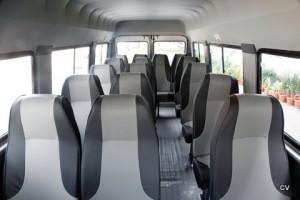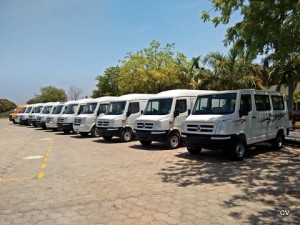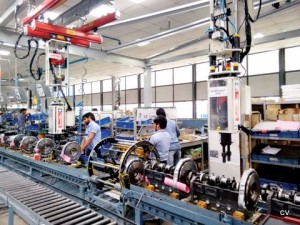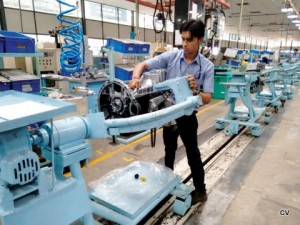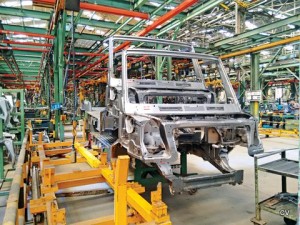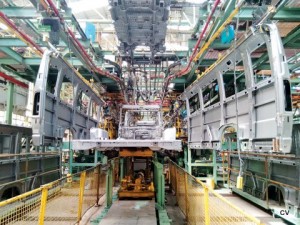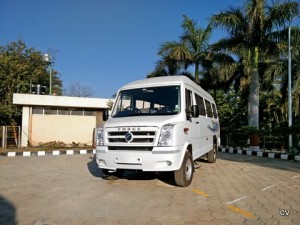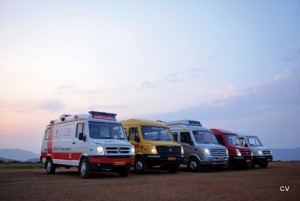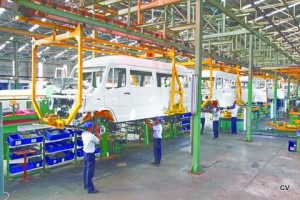From a first responder vehicle on an expressway to a conventional people or cargo transporter, Force Traveller has evolved in-tune with the changing market demands.
Story by:
Bhushan Mhapralkar
Force Motors launched a Smart Citibus at the Auto Expo 2016 by anticipating the infrastructural needs of a smart city. Based on a newer and wider (2.2 m wide) T2 platform, the Citibus is structured on a 4020 mm wheelbase, and can ferry 21 people apart from the driver. Typical of a feeder service bus that can manoeuvre through tighter spaces in a city unlike a 12 m long bus, the Smart Citibus is lighter, efficient and agile. Emerging out of a highly successful panel van that the Traveller is, the Smart Citibus is powered by a 129PS, 2.2-litre common-rail diesel engine (there is an option of a 80 PS, 2.6-litre CNG engine too) and features an intelligent passenger information system with sat-nav, jack knife door with low entry step among others. The Smart Citibus will add to the 1.5 lakh Travellers that have been sold till date.
A clear leader in the 16- to 19-seat panel van segment, an estimated 1200 to 1500 Travellers are sold every month on an average. They roll out of the factory at Pithampur near Indore, which was set up in 1987. Spread over an area of 6.85 lakh sq. m., the construction of the factory began in 1985 with the Government of India allowing new entrants to enter the light commercial vehicle segment. Existing manufacturers were allowed to expand capacities and modernise as well. It was decided after a considerable search, according to Dr. Abhaykumar Firodia, Chairman, Force Motors, to set up the Traveller plant at Pithampur in Dhar district near Indore. Dhar was the only district, south of the Vindhya mountains, which was designated as a ‘no industry’ district. The permission to expand and modernise was available only on the condition that the plant would be set up in a ‘no-industry’ district. Forced to go out of Pune, in retrospect, this was a good occurrence.
The Daimler connection
Producing a panel van derived LCV called the Matador, born out of a collaboration with Vidal & Sohn Tempo Werke of Germany, it was logical for Force Motor to turn to Daimler-Benz AG when the time to introduce a new product came. A series of mergers in the 70s saw Vidal & Sohn Tempo Werke being acquired by Daimler-Benz AG. The German share interest in Force Motors (called Bajaj Tempo Limited then) changed hands, and ended up with Mercedes-Benz. “When the question of expansion, modernisation and technology infusion came up in 1985, it was natural to approach Mercedes-Benz,” said Firodia. He stated, “After a detailed interaction with Daimler, it was decided to produce the Traveller Van – the T1 Transporter – in India.”
The Mercedes-Benz OM 616 diesel engine was already in regular production at Force Motors under license from Daimler. It was used to power the Matador. This engine was deemed fit for the Traveller, and, thus rolled out the first nine-seat Traveller structured over a 3050 mm wheelbase from Pithampur with the OM 616 motor located longitudinally at the front with the drive going to the rear wheels through a modern, smooth-shifting five-speed manual gearbox. Stress on localisation saw the driveline being localised quickly. Progressively body localisation (Traveller is a monocoque body construction) took place with investment in body tooling. “Daimler with their experience in setting up new plants and high technology manufacturing establishments supported the design, development, erection and commissioning of the factory at Pithampur,” mentioned Firodia.
Ahead of its time
The Traveller cut a premium image over the aging Matador. It was significantly costlier than the Matador even though the looks of the van were a big draw. “The German Deutsche Mark, which was at Rs 4.00 level in 1985, rose to Rs 20.00 level in 1989. This placed a huge stress on the costing and selling price of the Traveller. Body localisation would have meant enormous investment, and as imports meant very high import cost for imported pressed parts, it was decided to continue producing the Traveller in small numbers,” averred Firodia. Some 100 numbers were produced initially for a few years. Production rose. Simultaneously, strong localisation efforts with the setting up of a R&D and tool room at Pune, were exercised. Short wheelbases (3050 mm and 3350 mm) in high roof version were offered. Their strong structure, would help them endure the not so good roads in the country. Infrastructure was not as good then. The seating capacity increased to 14-seats. The phasing out of the Matador in 2000 saw the Traveller gain traction. Till then, it was not even preferred as a cargo carrier. There were many other options available. Over time, the rear-wheel drive layout, modern mechanicals, strong build, reliability, modern appearance, and comfort levels came to be appreciated. A small bonnet contributed to the sense of safety. The distinctive grille and inset lamps drew attention. A distinctive window-line marked the sides. The tail lights were placed in the pillars; two large doors hinged at the sides ensured easy access due to low floor height.
Evolution in-line with changing market needs
Staying true to its unitary body construction and robust mechanicals, the panel van, post 2005, gained new wheelbases at 3700 mm with 17-seats capacity, and 4020 mm with 20-seats capacity. A modern manufacturing infrastructure meant the Traveller body was electrophoretically painted from day one. The entire body could be immersed in an electrically charged primer paint. This has now given way to Cathodic Electro-Deposition (CED) and a Durr-based fully-automated paint line. “Expanding the capacity of a monocoque structure is tantamount to complete re-engineering of the body structure. This was made possible by strong Computer Aided Engineering (CAE) capability at the R&D. Substantial amount of tooling in terms of press tools, welding fixtures, etc., was achieved by the modern tool room,” stated Firodia.
In 2012, a 26-seat Traveller was developed. It involved the manufacture of a set of new, large tools. The entire floor, the entire roof, the entire front and rear walls would be larger and wider. They would all have to be separately tooled. Thus was born the T2 Traveller. Expressed Firodia, “The investment and the engineering effort in creating the wide body Travellers were made with a view to cater to the 26-seat passenger segment, and to provide a delivery van with higher volume and payload capacity.” If the T1 Traveller measures 1975 mm in width, the T2 Traveller measures 2225 mm. The T1 is had with a 3050 mm wheelbase, 3350 mm wheelbase, 3700 mm wheelbase and a 4020 mm wheelbase. The T2 is had with a 4020 mm wheelbase only. Flaunting a modern fascia with a horizontal slat grille that looks noticeably wider on the T2; the current model Traveller comes with clear lens head lamps. They are a single unit with the turn indicators integrated into them.
Truly Diverse
Playing many roles (as a passenger carrier that can ferry between nine and 26 people; as a school bus that can ferry between 12 and 37 pupils; as an ambulance that is designed for advanced life support, basic life support and for four stretchers at the same level; as a delivery van that would offer between nine cu m. of space and 17 cu m. of space, and as a city bus that ensures efficient last mile connectivity, the Force Traveller is truly diverse. It is exported to countries like Sri Lanka among others. Offering an advantage of letting people stand inside, courtesy the high roof, the Traveller, except for a choice of a flat roof in the 3050 mm wheelbase nine-seater version comes with a high roof. The T1 Travellers have 2×1 seating arrangement. The T2 Traveller offers a 2×2 seating arrangement. If the people carriers are flush with trim inside, and often customised by many buyers to their finer tastes, the cargo Travellers (termed as Traveller DV) come sans any roof trim inside. The cargo hold area behind the driver and co-passenger seat is separated by a ‘strong wall’.
The driveline
Two engines power the Traveller. A 2.6-litre four-cylinder direct-injection diesel engine based on the OM 616, and a 2.2-litre (TD2200) double overhead cam common-rail diesel engine with dual mass flywheel in BS III and BS IV guise. Over time, the OM 616 engine has been tweaked to include a turbo and an inter-cooler. It produces 80 PS of power and 230 Nm of torque. The 2.2-litre engine is more modern of the two. Peppy and refined, it could be had with a variable geometry turbo. A 3.2-litre five-cylinder diesel engine is in the works. Not to let go, the 2.6-litre engine has been upgraded to include a Bosch common-rail injection system. The five-speed manual gearbox has been suitably modified to account for higher power and higher torque. Also on offer is a BS IV compliant 2.6-litre sequential injection CNG engine that does 78 hp of power and 180 Nm of torque.
The 2.6-litre engine is mated to a G18/5 transmission; the 2.6-litre common-rail injection engine is mated to a G28/5 transmission; the 2.2-litre common-rail injection engine is mated to a G32/5 transmission, and the soon to be offered 3.2-litre engine will come with a new, G33/5 transmission. Either gearbox offers good shift quality. Not exactly short or precise, but quite car-like none the less. Transmissions over time have been suitably tweaked. According to Firodia, significant engineering effort was involved in integrating high horse power engines. “The entire engineering was carried out in-house. The basic engineering designs of the TD 2200 engine and the G32 gearbox were in the 90s sourced from Mercedes-Benz, by way of separate technical licenses,” Firodia stated. To account for the higher power and torque output of the 2.6-litre common-rail injection engine, the gearbox has been suitably modified. The transmission gears have been grounded for higher strength. The mounting plate has been suitably modified.
Technology
Every stage of the Traveller’s manufacturing process reflects the use of technology. Big and heavy presses turn out large pressed sheet metal parts. The process of building a monocoque (unitary) structure begins with the welding of floor pans with a square tube cage underneath. This is followed by the marriage of the cowl, sides and the roof. There’s an amount of automation built into the body shop. The BIW is transported to the CED booth and is treated to a zinc phosphate treatment. Post the painting in robotised paint booth, the Traveller monocoque finds its way to the final assembly line. Sub-assembly lines feed sub-assemblies to the main line. A reflection of technology is also visible in the Traveller’s drivetrain as it is married to the body apart from the axles, wheels, trim, and various other bits down the final assembly line. The Traveller could be had with ABS, EBD, pneumatic rear suspension, and telematics; the T2 comes with all-wheel disc brakes.
The drive
The large driver’s door of the Traveller facilitates easier ingress. The seat is comfortable and the driving position is commanding. The view ahead through the large windscreen and past the small bonnet is uninterrupted. For a van that measures 6065 mm in length and 1975 mm in width, the Traveller feels compact. Moving away smartly, an amount of the sound from the 2.6-litre direct injection turbo-diesel engine does intrude into the cabin. Acceleration is linear. The pedal feels a bit stubborn, but yields results none the less. On the move the van tends to shrink around the driver. Capable of seating 17 people apart from the driver (17+D), this one could be had in four permutations and combinations. Available in a high roof configuration, this particular van, was fitted with high back seats. The steering is non-assisted. Turns at low speeds call for an amount of effort. Riding on 215/75 R15 tyres, an amount of steering effort is required even though it is considerably less while manoeuvering. Feeling refined, an amount of engine noise filters through. Vibes are kept well under control. This, despite the engine’s longitudinal positioning. A portion of the engine intrudes into the cabin, between the driver and the front co-passenger. Reflecting on the panel van’s ability to ferry people in good levels of comfort, the 17-seat Traveller could be had in eight guises differentiated mainly by the engines. So, apart from the 2.6-litre engine that is powering this van, the 17-seat Traveller could be had with a 2.2-litre common-rail turbo-diesel motor or a 79 PS 2.6-litre CNG engine mated to a five-speed G1-18 transmission. The most selling among the 120 Traveller iterations on offer, this van is a honest offering. The dash is simple and functional. The seating configuration is 2×1.
The air-conditioned T1 Traveller Super measures 5415 mm in length and 1975 mm in width. Crank the 90 hp 2.6-litre BS IV compliant common-rail turbo-diesel motor and it settles down to a refined idle. Coming closest (among the Traveller variants) to feeling like a car, the Super produces 250 Nm of torque between 1400 and 2000 rpm. Seating nine people in good comfort apart from the driver (9+D), it is a far cry from the earlier 17-seat model. The G28/5 five-speed gearbox feels smoother, and past the tall first gear, the second and third gears, bring out the peppy nature of the van. Impressive refinement levels, and a power assisted steering makes for an easy drive. The fairly compact dimensions add to the excitement of driving this van. Fitted with glued glass windows, factory fitted air-con, twin blowers, luxurious push back seats, ABS and EBD, the Super is truly impressive. The ride is pliant and handling is good. The van is fitted with a pneumatic rear suspension. The brakes, exerting a good bite, consist of ventilated discs at front and drums at the rear. Bring up the lighter side of the Traveller range, this is one van that would double up as a good activity vehicle and a comfortable large-family transporter.
The T2 is wide and long. From behind the wheel, it however does not feel as much. 250 mm wider than the T1, and fitted with two tyres at either end of the rear axle, making it a six-tyre vehicle, the T2, with a payload capacity of 2500 mm in a delivery van guise, feels easier to drive than anticipated. The view ahead is uninterrupted almost. The controls are within reach, and the design of the dash, though simple and functional, differs from that of the T1. Turn the key, and the 129 PS 2.2-litre variable geometry turbo-diesel engine comes to life and settles down to a steady idle. The G33/5 five-speed manual transmission supports easy shifts. Not quite peppy as the Super, the T2, feeling refined, takes off without any noticeable turbo lag. Acceleration is smooth and speeds build up predictably. The hydraulically assisted steering ensures easy manoeuvrability. The second and third cog find the most use in city driving conditions. The higher ratios are better kept for use on the highway. Delivering a pliant ride under a variety of conditions, courtesy the pneumatic rear suspension, the handling of the T2 is predictable. The brakes exert a good bite. They are discs all round, and are supported by ABS and EBD.
Young forever
Over three decades of its existence, the Traveller has carved out a niche for itself. A clear leader in the 16- to 19-seater panel van market, it has set a benchmark. Looking young as ever, the Traveller reflects on the company’s focus to produce vehicles which are utilitarian and address the needs of the common man. Consider the 26-seat Traveller for example. According to Dr. Abhaykumar Firodia it is the largest monocoque passenger van anywhere in the world. It weighs one-tonne less than any competing van; offers spectacular fuel economy, handling ease, exceptional safety and comfort for the passengers.



